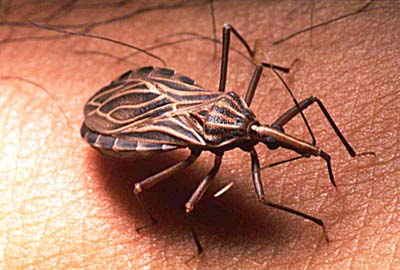 Recent cases of triatominae bug bites in Texas have health officials looking at how this tropical bug is spreading in the United States. Typically, these bloodsucking insects known as kissing bugs, which are more commonly found in South America and Mexico, will attack wild animals and not humans. Their common name comes from the fact that when they do bite humans it is generally around the lips or eyes while a person is sleeping.
Recent cases of triatominae bug bites in Texas have health officials looking at how this tropical bug is spreading in the United States. Typically, these bloodsucking insects known as kissing bugs, which are more commonly found in South America and Mexico, will attack wild animals and not humans. Their common name comes from the fact that when they do bite humans it is generally around the lips or eyes while a person is sleeping.
While the bug bite itself is menacing, the more serious concern is that the insect can carry the parasite Trypanosoma cruzi that causes Chagas disease. This protozoan, T. cruzi, can migrate to the heart and cause health problems including heart failure even decades after the original bite.
The kissing bug cases from Texas that are making news lately are raising concerns about the potential for an outbreak of Chagas disease. Currently, the incidents of Chagas disease in the U.S. is relatively low. While approximately 8 million people in Latin America are reported to have the disease, only about 300,000 people in the U.S. have the disease, according to the Centers for Disease Control and Prevention (CDC). Historically, the insects that carry Chagas were predominately found in more remote rural areas. In recent years, entomologists and health professionals are finding that the insects are moving into more populated areas.
While the several of the kissing bugs found in the Texas cases did carry the parasite that causes Chagas, the parasite itself was not found in any of the human bite victims. Health care professionals have been advising citizens to thoroughly wash any suspected insect bite. It is the triatomine’s fecal material, not the sucking mouth part that contains the parasite. When the insect bites a human it also generally defecates close by. People then accidentally transfer the parasite to their bloodstream via the wound when they go to itch or rub the bite. Educating school nurses, parents and the general public about how important it is to properly treat a recent bite can help minimize the Chagas threat.
In its early stages, Chagas mimics flu symptoms and may be mis-diagnosed especially if the patient does not reveal details about a bug bite. Health practitioners may not be aware of Chagas disease, since its incidence is not common in the United States. In its early stages it is easily and successfully treated with pharmaceuticals. Left untreated, however, it can be deadly. The CDC in conjunction with state officials are providing additional education through their website to keep health practitioners and the general public up to date about this important health concern.
References:
http://www.cdc.gov/parasites/chagas/epi.html
http://www.dshs.state.tx.us/idcu/health/zoonosis/Triatominae
http://www.utexas.edu/news/2011/10/06/chagas_disease









